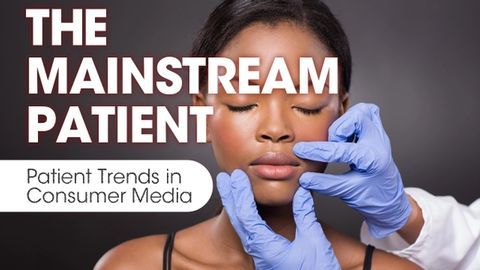- Case-Based Roundtable
- General Dermatology
- Eczema
- Chronic Hand Eczema
- Alopecia
- Aesthetics
- Vitiligo
- COVID-19
- Actinic Keratosis
- Precision Medicine and Biologics
- Rare Disease
- Wound Care
- Rosacea
- Psoriasis
- Psoriatic Arthritis
- Atopic Dermatitis
- Melasma
- NP and PA
- Skin Cancer
- Hidradenitis Suppurativa
- Drug Watch
- Pigmentary Disorders
- Acne
- Pediatric Dermatology
- Practice Management
- Prurigo Nodularis
- Buy-and-Bill
Article
The Mainstream Patient: November 14
Author(s):
This week's edition of the Mainstream Patient features stories about "botox in a bottle" products, how to treat cystic acne, face positivity, and more.
In this week’s edition, New Beauty explores the best skin care routine for acne-prone and over 50 skin and Vogue lists 9 "botox in a bottle" products. Cosmopolitan explains how to treat cystic acne at home and with a dermatologist and Self reveals the best skin care tips from a dermatologist. Elle discusses face positivity and Allure looks at the difference between botox and fillers.
The Ideal Skin-Care Routine for Acne-Prone, 50-Something Skin
For many women in their 50s, hormonal acne may send skin back to high school as menopausal breakouts develop in women for much the same reasons that pop up during puberty. Hormone imbalances during menopause affect our skin’s natural defenses and trigger constant acne breakouts. When she’s working with a client experiencing acne, no matter the age group, medical aesthetician Amy Peterson says the first step is the dermatologist’s office.“ You should visit a dermatologist to have your bloodwork done and get to the root cause of your acne and make sure you know what is causing it,” notes Peterson. Once the trigger has been identified, experts say these products and treatments have helped them lead maturing clients to clearer, healthier-looking skin.
Botox in a Bottle? These Skin Care Products Deliver
Every time we open our TikTok app, we’re inundated with a new beauty trend users can’t stop raving about. While many aren’t worth a second thought, the “Botox in a bottle” videos left us wanting to know more. Though we’re in full support of people heading to an expert for whatever cosmetic treatments suit their fancy, we’re intrigued that there might be a needle-free method right at home. So, we tapped three dermatologists to weigh in.
How to Treat Cystic Acne at Home and With a Dermatologist
If you’ve ever gotten cystic acne or an underground blind pimple, you’re probs very familiar with the feeling that is wanting to remove your own skin and borrow some from a baby (was that motivational? Inspirational? Worrisome? Sry—I’m breaking out right now, can’t help). Because cystic zits suck. They do. There’s no making friends with a pimple that throbs when you sleep and aches when you smile, then peaces out three months later, only to leave you with a red or brown splotch that takes half a year to fade.
The Best Skin Care Tips I Learned From My Mom, a Dermatologist
Growing up as the daughter of a dermatologist, I’ve gotten used to friends, acquaintances, and strangers alike asking me all sorts of skin care questions—from someone I was dating asking me to assess his rash to friends requesting a full review of their skin care routine. Unlike my mom, I didn’t go to medical school, so I’m completely unqualified to diagnose or treat any skin issues, of course. But that doesn’t mean I haven’t gained some secondhand knowledge from being around her.
Body Positivity Is a Bona Fide Movement. Why Not Face Positivity Too?
If I had a dollar for every time someone suggested, unsolicited, that I “fix” my face, I might have amassed enough to fund one of those costly procedures by now. My childhood dentist told me that if I didn’t do something drastic to address my strong jawline, I’d look like Jay Leno by the time adulthood neared. Years later, as an assistant with no health insurance, I was told by another dentist that I “needed” cosmetic jaw surgery. Then there was the makeup artist who, when I arrived on the set of a shoot, promised “we can make your nose disappear!” and proceeded to contour me to the nines. Shamefully, I was so happy with the results that I ended up using the photo as my professional headshot, trying not to let any candid shots slip through the cracks.
Botox Vs. Fillers: Experts Explain the Difference Between the Injectables
Welcome to the wonderful world of injectables. If you're new here: Don't be scared! Yes, there are needles involved. But you might discover that a pinch or two is totally worth it (and more people are doing it than you think). Your first lesson covers the basics: Botox vs. fillers.
Newsletter
Like what you’re reading? Subscribe to Dermatology Times for weekly updates on therapies, innovations, and real-world practice tips.



